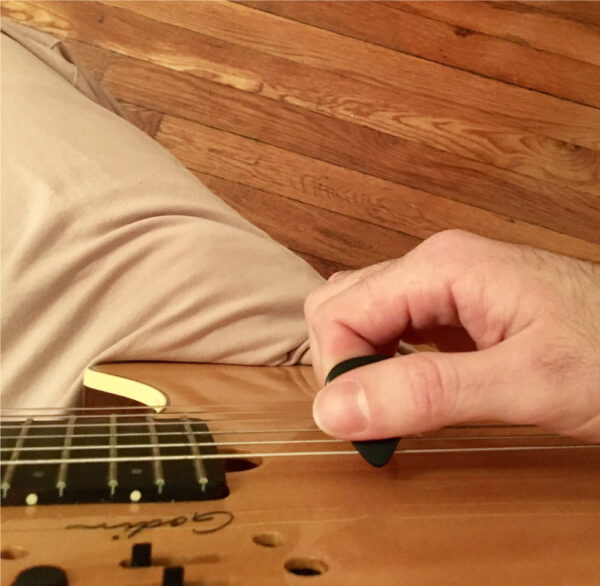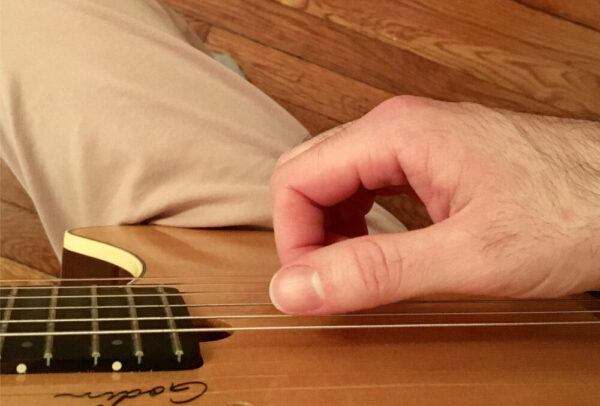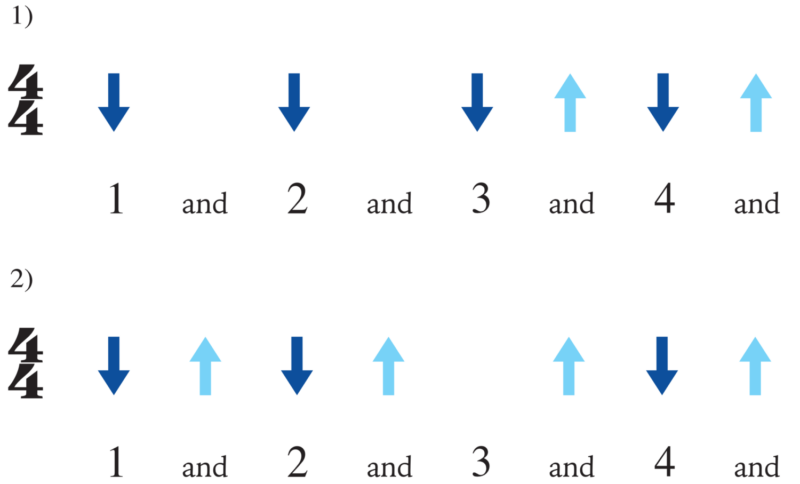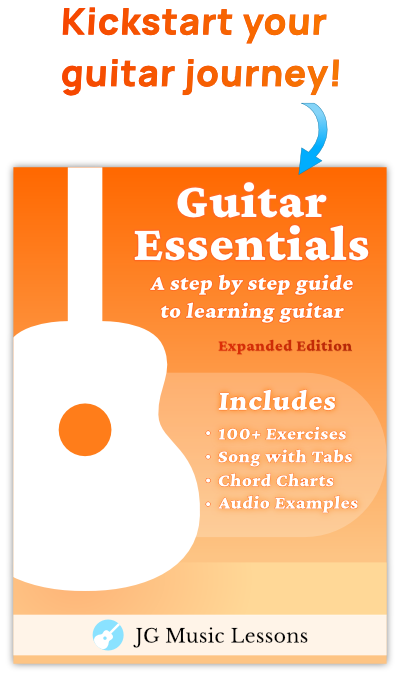If you’re learning to play guitar, you’ll find that strumming is an essential skill to learn on the instrument. Before you even start learning to play single note melodies, riffs, or solos, I think strumming is an excellent way to get into learning to play guitar.
Having a good sense of strumming allows you to play your favorite songs, helps you to accompany yourself, and other musicians or singers you might be playing with. In this post, we’ll cover 7 ways you can get better at strumming on guitar.
If don’t know how to strum yet, see strumming tips 1 and 2 to get started. If you already have some experience with this, then you can skip and continue reading from tip 3. Let’s get started!
1. Find the strumming technique that works best for you
If you’re completely new to strumming, there are two main ways to strum a guitar.
Technique 1: Using a pick
By using a pick, you get a clean, bright, and consistent sound which can be easier for strumming chords. The way you come down on the strings is the same way you would come back up.
Tip* Make sure to have a good grip on the pick so that it doesn’t fly out while you’re playing. At the same time try not to tighten your wrist but keep it relaxed so that you can strum more comfortably. Your wrist can rotate slightly but you shouldn’t need to overdo it.

Technique 2: Using your fingers
If you’re using your fingers to strum, it’s best to use your nail to get a clearer sound as opposed to using the fleshy part of your fingers (that would be uncomfortable and it also muffles the sound of the strings). To strum back up, you can also use the nail on your thumb to get a clearer sound. Like with the picking technique, you shouldn’t need to over rotate your wrist when strumming and also try to keep your hand and arm relaxed.
You can also check out this lesson on how to fingerpick on guitar which goes more in depth on this topic.

It’s helpful to figure out what strumming technique will work best for you. but it’s never too late to switch over or mix them up in different musical situations. If you’re not sure which method is better to use, check out this post on picking vs. using your fingers.
2. Master a basic pattern to strum up and down consistently
The first thing you want to be able to do is to strum up and down consistently. Think of 4 beats that keep repeating (these beats make up a fragment of time called a ‘measure’ that repeats in 4/4 time.) 4/4 is a common time signature used in music. There are other time signatures like 3/4 and 6/8 but we’ll stick to examples in 4/4 for now.
You can count these numbers out loud as you strum.
If you’re strumming down on each beat, it would look like this:

Then, if you were to divide each beat in half, you can count “1 and, 2 and, 3 and, 4 and”. Now you could strum up in between each beat like this:

I recommend strumming down on the strong beats which fall on the numbers and strumming up on the ‘ands’ in between those beats, which creates a consistent alternating pattern when you have a series of repeated strums.
Easy guitar strumming examples
Now that you have a basic idea of how strumming works, try these examples that sound more musical when you skip strumming on certain beats. Try looping each example once you get the pattern down.
You can use any chord you like to play these examples. However, I recommend starting to practice strumming with chords that include all 6 strings like E minor, E Major, or G Major.
In these examples, let the chords ring out when a strum isn’t indicated.

Once you get these down, you can try the same patterns with chords that start from the 5th string down like A minor, A Major, or C Major.
Check out the first chords you should learn on guitar if you don’t know the ones we covered here already.
To try more examples, I recommend going over these 12 easy strumming patterns on guitar.
After the basics
If this information is already familiar or too easy, read the following tips to get your strumming to the next level.

3. Add muting to your strumming
A cool effect that adds interest to your strumming is to mute certain beats in a pattern. This is simply done by placing your strumming hand over the strings which can add a percussive effect to bring contrast in a pattern.
In the following examples, the X represents a mute.

Experiment using these mutes to accent different parts of a strumming pattern. We cover more muting methods and examples in the ebook, Guitar Essentials.
4. Learn strumming patterns of your favorite songs
One of the best things you can do to take your strumming to the next level is to learn a variety of patterns from your favorite songs. After 5 – 10 strumming patterns from different songs, I think you’ll see a difference in the way you hear and approach strumming. You might need to look up the notation at first but ideally, you will want to learn the pattern by ear.
Read here for more on how to develop ‘ear training’.
The reason I recommend learning different strumming patterns is that they help you to develop a better sense of rhythm. The physical act of strumming isn’t too hard to learn but it’s having a good sense of musicality that makes your strumming sound better.
5. Use a metronome
A metronome is a tool that produces a steady clicking sound or beat at a tempo you choose. Playing with a metronome helps you determine if you’re staying in sync with the rhythm consistently. Take any strumming pattern you’ve learned and play it along with a metronome to see if you’re keeping good timing.
By the way, here’s a free metronome on our site.
When practicing with a metronome, always start slowly to make sure you have a pattern down in time before playing it faster. Then you can gradually increase the speed of the metronome to practice the same pattern in faster tempos.
For example, start at 80 beats per minute (bpm), then 100, then 120, etc… to challenge yourself. The point is not to just be able to play things fast but also to develop a good sense of groove/feel to your strumming.
Dread the idea of practicing with a metronome? Check out 6 benefits of recording to practice music.
This brings us to our next point…
6. Think like a drummer
You might be thinking ‘I thought I came here to learn guitar…’ but my point here is that if you learn to follow the strong beats and accents in a song, you’ll be able to strum something that fits more naturally with other instruments.
After having learned the main strumming pattern of a song, don’t limit yourself to keeping the same thing for the entire song. Also, there are usually rhythmic variations on different sections of a song so you will want to change up your strumming to match those parts.
You want to try switching up a strumming pattern or mixing up patterns so that it doesn’t sound too repetitive. You’ll find that if you listen closely to a recording, you rarely have the same pattern throughout a song.
Again, this is where the muting we talked about earlier comes in handy to make your strumming sound more interesting.
7. Recording yourself
Another effective way to improve your strumming is to try recording yourself. It can be as simple as recording audio or video on your phone to hear what your strumming sounds like. If you have software like Garageband or a more in-depth program like Logic Pro, then you can record different layers and sections which you can loop and playback.
If recording music is something you’re looking to get into, you might also want to check out the 6 reasons why you should use recording software to practice music.
For example, with a recording program, you could set a drum pattern you like, and then you can add a layer of chords over it. You can add a variety of sounds and loops which makes the experience very customizable and fun to use.
You can try use using this method to hear how you can improve certain parts of your playing as well as get into a creative process to start making music.
It can be easy to be overly critical when hearing yourself play but understand that you’re on a journey to get better which takes time and effort. Enjoy the process and take it one step at a time.
Wrapping up
To recap, the 7 ways to get better at strumming on guitar are:
- Find the strumming technique that works best for you
- Master a basic pattern to strum up and down consistently
- Add muting to your strumming
- Learn the strumming patterns of your favorite songs
- Use a metronome
- Think like a drummer
- Record yourself
Whether you prefer finger picking or using a pick, these tips will help you develop and refine your strumming skills. To see improvement in your strumming, I recommend applying on some of the tips that you haven’t explored yet. Keep at it and over time strumming will become more natural to you.
If you want to learn more complex rhythms using a fingerpicking technique, check out how to play Bossa Nova rhythms on guitar.
📘 Get the free guitar practice guide here!
All the best,
JG Music Lessons
Original photo by Brent Keane from Pexels
📙 Kickstart your guitar playing with our step by step guide: Guitar Essentials.
🎸 Looking for a travel or half-sized guitar? See this one.
🛠 See our other music recommendations.
🤝 Support the site to help us to create better content for you!
Level up with the FREE guitar practice guide and effectively improve your playing! 🎸
Get it sent to your email!



